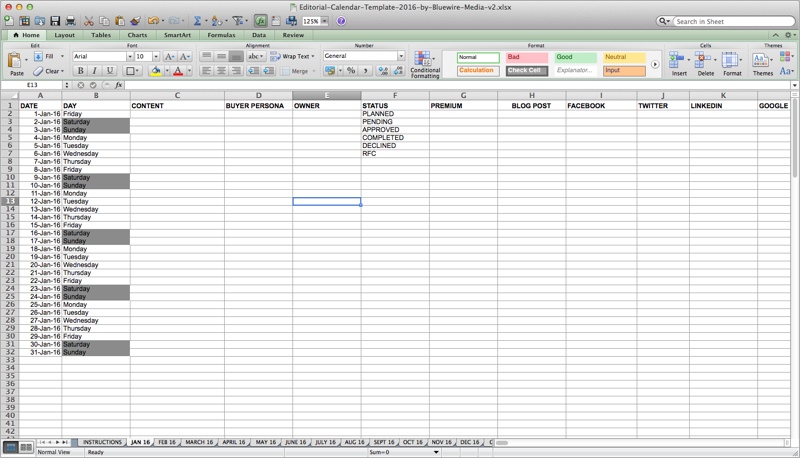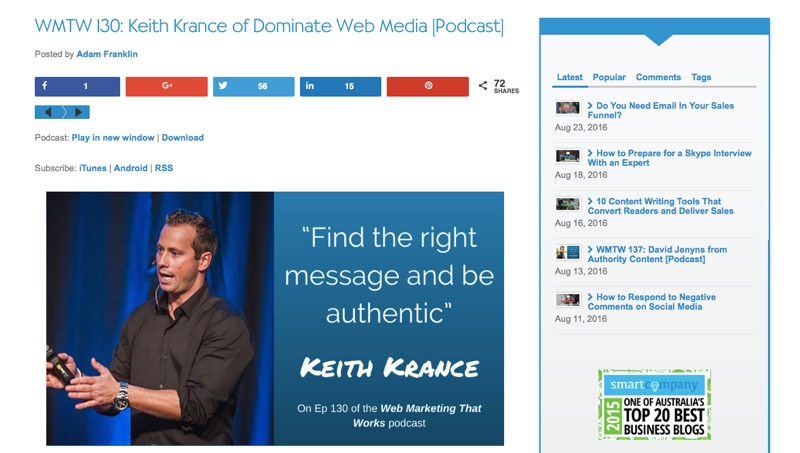How to Create a Yearly Content Marketing Calendar (Step-by-Step)

Do you struggle to maintain a consistent posting schedule across your blog and social media channels?
Perhaps it feels like a never ending loop of missed deadlines, peaks, troughs and no one in your team REALLY taking ownership of anything?
You certainly aren’t alone with this battle, but there is one thing that the best content marketers swear by for overcoming it…
A content marketing calendar.
A well thought out content marketing calendar gives you organisation, accountability, deadlines and a common place to collaborate with your team. But they aren’t that easy to put together.
Creating an editorial plan and calendar for marketing your content can turn into a monumental project if you don’t know where to start, and don’t have the appropriate tools to help you along the way.
We find it’s helpful (before just diving in blindly and tackling that kind of project) to start with a template or some guidelines. That’s why we created the Editorial Calendar Template to help people in our audience get their blog and social media planning back on track.
This template is one of the most popular downloads in our 33 Web Marketing Templates, and you can download a copy below.
The rest of this article will take you through step-by-step how to use it.
The Importance of Planning Out Your Content
We all know that good content marketing can help build your business and generate leads.
But just having good content by itself won’t cut the mustard. Knowing what you need to publish, when you will publish it and how you’ll share that content is crucial to building a successful content marketing strategy.
Your content marketing calendar will help you and your team accomplish several key tasks:
- Planning out your content for the entire year, so that you’re incorporating events and important dates ahead of time
- Determining where you need to create more content, or perhaps you have overlapping objectives
- Creating a consistent publishing schedule for your content marketing channels
- Presenting a visual representation of your content strategy that everyone can see
- Allowing team members or external contributors to collaborate all in the one place
- Ensuring that you’re meeting your content marketing goals for the year and have the time and resources to publish that content
Using The Editorial Calendar Template
Now it’s time to take a look at our template to help you build your very own content marketing calendar.
On the first tab of the spreadsheet there are instructions and a legend for the calendar, this will help you get familiar with how you will be using it.

Each item in this list corresponds to a column in each sheet of the template, which is broken down into months for the entire calendar year.
Here is a snapshot of what each month looks like in the template:

Content
What type of content will you be sharing?
Here are some options:
- Publishing industry research that you have conducted
- Putting together an infographic (Like ours on the Web Strategy Planning Template)
- Creating a how-to video
- Doing an FAQ page or Q & A session (Like this example from Dropbox)
- Hosting a webinar or online event
- Running an offline event or giving a presentation
- Releasing a case study
- Doing an expert interview (We do this regularly on our podcast, like the one below with Keith Krance)
- Reviewing a product or tool from your industry
- Collating industry news or must-read articles
- Releasing a short course or email series
- Running a poll or survey (Use a free tool like Google Forms to create one)
- Leveraging user-generated content
- Announcing a new product or service
- One word of wisdom,is to be certain that you are accidentally plagiarising someone else’s content. Here are some tips to avoid plagiarism.
Describe what the content is going to be in the first column of the spreadsheet and when you plan on releasing it.
Buyer Persona
Your buyer persona is up next. Creating buyer personas help you identify exactly who you are trying to talk to, where they are going to be and how you can best connect with them.
Your buyer persona will look a little something like this:
Hopefully you have already created your buyer personas, and for the purpose of the spreadsheet you are just jotting down the persona that you will target with this piece of content.
The more personal and tailored you can make your message for one unique kind of person, the better it will perform. As you are creating that piece of content, this persona should be your anchor point.
Nailing your buyer personas can also help to determine which platforms you’ll use to distribute your content.
Owner
In the next column, “Owner,” you’re deciding exactly who is responsible for sharing the content within your team – whether it’s you, your virtual assistant, your marketing manager or a team of brand ambassadors.
Creating ownership over a piece of content is the best way to establish accountability and ensure deadlines get met. The word “deadline” sounds like it is urgent… But it doesn’t have to be. It’s more about planning ahead so there are no surprises and everyone is on the same page.
Status
The next column indicates the status of the content, and, when you select one of the dropdown options, the template will automatically update the colour of the row to tell you what the status of that content is.
The colour legend for the status column explains what each status means, and will give whoever sees the calendar an idea of what exactly needs to be completed for that content.

The great thing about updating the status of your content marketing calendar is that it helps people understand where everything is at, and what needs to get done next. It’s also another a great way to create accountability within a team, because if someone has “Ownership” of a piece of content but they have left it in “Pending” for a time beyond it’s deadline, they will feel responsible to complete it.
Distribution
The next few columns in the template are where you indicate how and where your content is being distributed.
Think about the following when you share on these platforms:
- Twitter – are you linking to a particular blog post or landing page on Twitter? How many times should you send this out for it to be effective? (Be sure you’re keeping within the 140-character limits!)
- Facebook – are you sharing a status update or event announcement, and is there a corresponding image that you’ll need?
- Blog Post – is the content a blog/article that you’ve written? Or is it something else? How does SEO play a part in this part of the content calendar?
- Email – is the content your weekly or monthly newsletter? Or perhaps it is going to alert your email list of something important through a broadcast?
- Website Update – have you added more services, or discounted pricing for your product?
- Media Release – do you have news to share about your company? Who is going to distribute this for you?
Obviously you’re not going to dive in and start filling out the entire calendar immediately. That might induce some kind of panic attack, and we don’t want that.
Start by figuring out the content that you have already produced, and where you might fit that into the calendar. Look at the year ahead and determine which events you’re already planning for – maybe there’s an industry conference that you want to attend, and you have ideas for blog posts that you can publish to help build some brand awareness before you get there.
You should have an idea of how much content you and your team is capable of producing, and from there you can start planning out new ideas and strategies.
Oiling Up Your Content Machine
We love a good content marketing calendar because you’re able to see how you are distributing content and equip your team for creating additional or updated content. The key word in that last sentence is “updated.”
If there’s one thing to remember, it’s that content can be refreshed and repurposed – you don’t need to constantly churn out brilliant blog posts, images and e-books all the time in order to have an effective content strategy.
For example, if you’ve already written a blog post on a topic, consider how you can use that blog post again. Maybe you wrote about the best self-help/motivation books of 2016 (so far) – consider using that post again and updating it at the end of the year. If you created an infographic about how millennials use Snapchat, publish a Youtube video explaining the data points that correspond with your infographic.
Some other great ways to repurpose your content include:
- Turning a presentation into a SlideShare
- Making a video from a webinar
- Creating a guide from a series of blog posts
- Using your blog posts as an auto-responder email sequence
Content Marketing Calendars = Marketing Sanity
The entire reason behind this kind of calendar is so that you have a high-level view of the resources and time that you’ll need to build a strong content marketing strategy. Knowing ahead of time when you’ll be sharing a post or distributing your newsletter will help you prioritise and meet your business goals.
The point of seeing an entire year’s worth of content is to help you make sense of why and how you are producing your content.
Aligning your content with your business goals, and planning it out ahead of time, will help you to set benchmarks and adjust or improve where needed.
How far ahead do you plan out your content? Have you set up an editorial calendar for your marketing team?
Content Marketing Sales Funnel
Your content marketing sales funnel is all about getting people to know, like and trust you by nurturing them with the right information at the right time.






